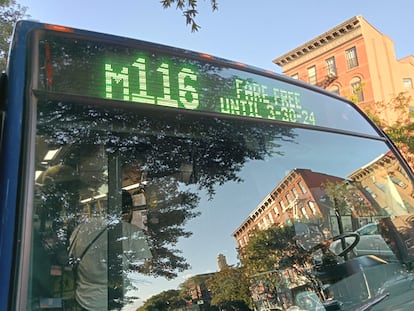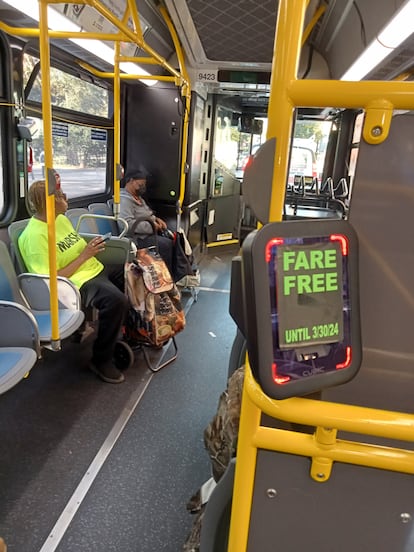New York rolls out free public transportation pilot project on five city bus lines
The routes are located in low-income neighborhoods, where the population depends on surface transportation. The White House has committed to reducing the sector’s carbon footprint by 85% by 2050


After the heavy rains that have fallen in recent days on the Big Apple, a pilot program by the Metropolitan Transportation Authority (MTA) offering free travel on five city bus routes was rolled out this week. Five lines — one for each county or borough of New York City — will offer free rides for at least six months, extendable to one year, in an experiment mimicking others in cities like Boston, which has operated three free routes since March 2022, and Kansas City, which has implemented zero fares throughout its network as of 2020.
As in Boston, where more than half of the users of the free lines live in low-income neighborhoods, the New York experiment seeks not only an environmental benefit, but above all to alleviate the unequal mobility of its residents in pursuit of greater spatial equity, which those who advocate alternative transportation models consider an essential step towards environmental sustainability. New York is theoretically moving towards this goal: the government of Joe Biden has committed to reducing the carbon footprint of transportation by 85% by 2050.
Against a backdrop of budget shortfalls — the MTA has not recovered its pre-pandemic passenger levels and has just raised its fares to $2.90 per journey — New York’s pilot program will benefit up to 44,000 people per day, a fraction of the bus network’s 1.3 million weekly users. The routes chosen are in low-income neighborhoods because only those who live in areas without subway access rely on surface transportation to get around. New York’s buses are the slowest in the country, with an average speed of 13 kilometers per hour (8mph). They are often excruciatingly slow, with runs that can exceed an hour in length.
The authorities have explained that the routes were chosen based on ridership, fare non-payment rates and poverty in adjacent communities, as well as the routes’ access to commercial corridors. That’s why Dora Smith, an African-American retiree from Manhattan, is pleased that one of the routes chosen is the 116 line, which takes her to a mall where several inexpensive supermarkets are located (another peremptory issue in the U.S. is the existence of food deserts, something even New York is not spared). “Before they were free, I came [to shop] only twice a month at most, because I couldn’t spend that much on transportation. Now that the shuttle is free, I can come buy fresh produce once a week without thinking about the fare,” she says.
On the 116 bus, which crosses northern Manhattan from east to west and vice versa, it is common to find the aisle crowded with shopping carts and bags from private label supermarkets. In the Bronx, where the Bx18 line connects unserved neighborhoods with big-box stores like Walmart and Best Buy, Minnie, a single mother of three teenage children, has enthusiastically signed up for the almost circular bus route: “At almost $3 a fare, this free line is a considerable saving. I used to come here weekly to shop, but now I can use the money I save on transportation to buy better food.”

Parking meter price hikes
Traffic congestion in New York is at the root of numerous feasibility projects, each one progressively more difficult to implement. The price of parking meters in the city will soon be raised by 20%, while tolls are being considered for major access roads to the boroughs such as the Brooklyn Expressway. The city is also studying the widening of two major expressways or freeways — asphalt scars that cut through entire neighborhoods — at a cost of $1 billion, a project that the TransitCenter group, which proposes alternative mobility models, believes should also involve “improving people’s lives and helping to reduce emissions,” says a spokesman. “We believe there are other ways to spend money and achieve both objectives.” Changes to the transportation model in a city of 8.5 million people is by no means an easy task.
Politicians and activists support free public transportation because they believe it benefits the city’s neediest residents — those most dependent on the system. But MTA officials argue that a totally free transit model is unfeasible if current revenues are not compensated by other sources, such as higher fares on other lines. In fact, the new pilot program initially intended to cover 10 routes, but its $15 million budget was not sufficient to cover expenses. A complementary part of the same plan, with a budget of $35 million, is the expansion of frequency on five subway lines linking the cardinal points of the city.
The experience of Kansas City, which with 500,000 inhabitants became the largest city in the country to eliminate fares systemwide in 2020, presents factors that are not easy to extrapolate. Kansas was able to implement a zero-fare program because the city didn’t pull in a lot of revenue from fares, something that is not comparable to metropolises such as New York. “Half the revenue [in New York] comes from fares,” TransitCenter executive director David Bragdon explained recently. “To just tell the MTA to go find billions of dollars is not a realistic political proposition.”
As a result of the Covid-19 pandemic, in 2022 New York City had the largest income gap between classes in the last 20 years and the city’s structural inequality — also enshrined in its urban planning — has skyrocketed. Encouraging mobility options could rebalance the scales, experts say. But existing examples in the U.S., far from offering solutions, underscore the peculiarities of the Big Apple, for better and especially for worse.
Sign up for our weekly newsletter to get more English-language news coverage from EL PAÍS USA Edition
Tu suscripción se está usando en otro dispositivo
¿Quieres añadir otro usuario a tu suscripción?
Si continúas leyendo en este dispositivo, no se podrá leer en el otro.
FlechaTu suscripción se está usando en otro dispositivo y solo puedes acceder a EL PAÍS desde un dispositivo a la vez.
Si quieres compartir tu cuenta, cambia tu suscripción a la modalidad Premium, así podrás añadir otro usuario. Cada uno accederá con su propia cuenta de email, lo que os permitirá personalizar vuestra experiencia en EL PAÍS.
¿Tienes una suscripción de empresa? Accede aquí para contratar más cuentas.
En el caso de no saber quién está usando tu cuenta, te recomendamos cambiar tu contraseña aquí.
Si decides continuar compartiendo tu cuenta, este mensaje se mostrará en tu dispositivo y en el de la otra persona que está usando tu cuenta de forma indefinida, afectando a tu experiencia de lectura. Puedes consultar aquí los términos y condiciones de la suscripción digital.
More information
Archived In
Últimas noticias
Most viewed
- Sinaloa Cartel war is taking its toll on Los Chapitos
- Oona Chaplin: ‘I told James Cameron that I was living in a treehouse and starting a permaculture project with a friend’
- Reinhard Genzel, Nobel laureate in physics: ‘One-minute videos will never give you the truth’
- Why the price of coffee has skyrocketed: from Brazilian plantations to specialty coffee houses
- Silver prices are going crazy: This is what’s fueling the rally










































